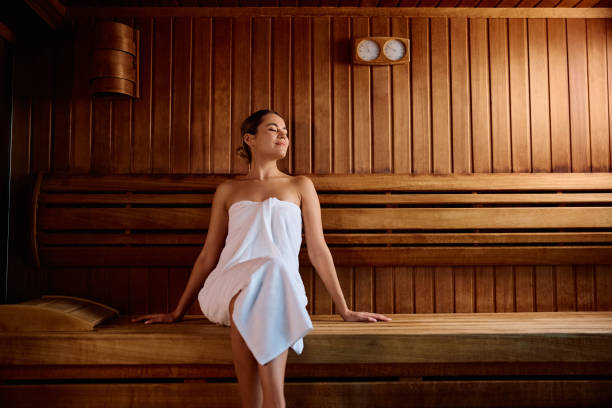Understanding House Saunas and How They Work
House saunas have been part of daily life in many cultures for centuries, offering a warm place to relax and enjoy quiet time. This article explains how saunas are built, the different styles used at home, and the simple process that makes the room warm. It also explores the traditions that shaped saunas, how they became common in modern homes, and what makes each type unique. By the end, readers will understand how saunas function and why they continue to be a popular part of home design today.

Installing a sauna in your home transforms your living space into a personal wellness sanctuary. House saunas come in various forms, each designed to deliver heat therapy through different mechanisms. The fundamental principle remains consistent: controlled heat exposure in an enclosed space promotes sweating, relaxation, and potential health benefits. Modern technology has expanded the options available to homeowners, making it easier than ever to incorporate a sauna into residential settings.
What Are the Key House Sauna Benefits
House sauna benefits extend beyond simple relaxation. Regular sauna use may support cardiovascular health by increasing heart rate and improving circulation, similar to moderate exercise. The heat exposure encourages deep sweating, which helps flush toxins from the body and cleanses the skin. Many users report improved sleep quality after evening sauna sessions, as the body’s natural cooling process following heat exposure promotes restful sleep. Muscle tension and joint stiffness may also decrease with consistent use, making saunas popular among athletes and those with chronic pain conditions. The private nature of a home sauna allows for flexible scheduling and eliminates the need for gym memberships or spa visits.
Exploring the Types of Home Saunas Available
Types of home saunas vary significantly in design, heating method, and installation requirements. Traditional Finnish saunas use wood-burning or electric heaters to warm rocks, which then radiate heat throughout the cabin. These reach temperatures between 70-90°C and typically include a water bucket for creating steam by pouring water over hot rocks. Infrared saunas operate differently, using infrared panels to directly heat the body rather than the air, maintaining lower temperatures around 50-60°C while still promoting sweating. Steam rooms, though technically different from dry saunas, create a high-humidity environment at moderate temperatures. Barrel saunas offer an outdoor option with efficient heat circulation due to their curved design. Pre-fabricated sauna kits provide convenient installation, while custom-built saunas allow complete design flexibility to match your home’s aesthetics.
How Saunas Work: The Science Behind the Heat
How saunas work depends on the heating technology employed. Traditional saunas use convection heating, where a stove heats the air and surrounding surfaces. As air temperature rises, your body responds by increasing blood flow to the skin and activating sweat glands to cool itself. The wooden interior absorbs and radiates heat evenly, creating a comfortable environment. Infrared saunas use electromagnetic radiation in the infrared spectrum, which penetrates skin tissue directly, warming the body from within rather than heating the surrounding air. This allows for effective heat therapy at lower ambient temperatures. Both methods trigger similar physiological responses: elevated heart rate, increased circulation, and profuse sweating. The body’s core temperature rises slightly, activating heat shock proteins that may support cellular repair and stress resistance.
Following a Practical Sauna Installation Guide
A sauna installation guide begins with selecting the appropriate location. Indoor saunas require adequate ventilation, electrical access for heaters, and flooring that can handle heat and moisture. Basements, bathrooms, and spare rooms are common choices. Outdoor installations need weatherproof construction and proper drainage. Electrical requirements vary by heater type, with most needing dedicated circuits and professional installation to meet safety standards. Pre-cut sauna kits simplify the process, including pre-assembled wall panels, benches, and doors. Custom builds require framing, insulation rated for high temperatures, and interior paneling with woods like cedar, hemlock, or aspen that resist warping and retain minimal heat. Proper ventilation is critical, typically requiring intake vents near the floor and exhaust vents near the ceiling to maintain air quality. Door placement should allow easy access while maintaining heat efficiency, with glass doors providing visibility and a sense of openness.
Considering Home Sauna Design Elements
Home sauna design balances functionality with aesthetics. Size considerations depend on intended users, with single-person units starting around 1 square meter and family-sized models requiring 3-4 square meters. Bench configuration affects comfort and heat exposure, with tiered benches allowing users to choose their preferred temperature level since heat rises. Lighting should be subtle and heat-resistant, with LED strips or specialized sauna fixtures creating ambiance without glare. Wood selection impacts both appearance and performance; cedar offers natural aromatics and rot resistance, while hemlock provides a lighter color and smooth texture. Interior layout should include proper spacing between the heater and seating to prevent burns while ensuring efficient heat distribution. Control panels allow temperature and timer adjustments, with modern systems offering smartphone connectivity. Ventilation design maintains fresh air circulation without creating uncomfortable drafts. Some homeowners incorporate windows for natural light and views, though proper glazing is essential to maintain heat retention.
Maintenance and Operating Considerations
Maintaining a house sauna ensures longevity and hygiene. Regular cleaning prevents mold and bacteria growth, with periodic wiping of benches and walls using mild, non-toxic cleaners. Wood surfaces benefit from occasional light sanding to remove stains and restore smoothness. Heater maintenance varies by type, with electric models requiring periodic inspection of heating elements and infrared panels needing occasional cleaning. Proper ventilation after each use allows moisture to escape, preventing wood deterioration. Energy consumption depends on sauna size, insulation quality, and usage frequency, with typical sessions consuming 2-6 kWh of electricity. Pre-heating times range from 15-45 minutes depending on the heating method and target temperature. Safety features should include temperature limiters, timers, and emergency shut-offs. Regular inspection of door seals, ventilation systems, and electrical connections maintains safe operation.
House saunas represent a significant investment in personal wellness and home value. Understanding the different types available, how they generate therapeutic heat, and the installation requirements helps homeowners make informed decisions. Whether you choose a traditional Finnish sauna with its high-heat experience or a modern infrared model with gentler temperatures, proper design and maintenance ensure years of beneficial use. The combination of health benefits, convenience, and property enhancement makes house saunas an increasingly popular addition to New Zealand homes.




